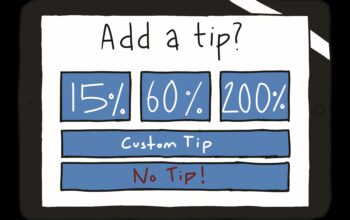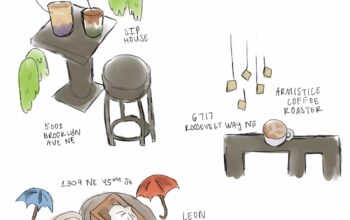
Content warning: Mentions of eating disorders.
In March 2020, the world entered an unprecedented period of isolation due to the COVID-19 pandemic. This past year has consequently been one of the most difficult and challenging times in modern history, particularly for young people beginning to find their way in the world. We’ve been stuck at home, bored, and uncertain about our futures, hoping to return to a sense of normalcy.
For some, one of the only constant and comforting aspects of quarantine life has been food. With empty schedules and lots of time spent at home, food has been a source of stability. A number of students have used quarantine as a time to explore new cuisines and expand their culinary skills. On TikTok, baking banana bread quickly became a trend along with whipped coffee and pasta dishes.
However, diet culture and exercise regimes quickly took center stage. Many teenagers posted about their hopes to use this time to “glow-up” and become their best selves. While this is a perfectly reasonable aspiration, ideas and trends of a “perfect body” have become increasingly toxic.
Eating and relationships with food have been sensitive topics for decades as trends, new diets, and ideal bodies go in and out of fashion. And for many, spending so much time at home has complicated relationships with food. It can be easy to turn to snacking when boredom creeps into our days, and equally as easy to fall into the trap of forgetting to eat due to the lack of schedule.
In a survey of Roosevelt students, 34 participants commented on how quarantine has affected their relationships with food, exercise, and their bodies. A majority of 85% noticed a change in their eating habits. About 65% cited a worsened relationship with food.
When asked to elaborate on their answers, many participants noted that with the lack of a schedule and routine, meal times are unstructured and up for interpretation, leaving people susceptible to both snacking and forgetfulness. Participants expressed difficulty restricting food when the kitchen is just a room away.
In regards to physical activity, about 40% of participants said quarantine hasn’t changed anything about their relationship with exercise while 35% said it strengthened their relationship with exercise. Students explain how the additional time has allowed them to exercise and move their bodies in new ways that suit their lifestyle. An anonymous survey participant says, “I have more time to work out now and can fit it into my schedule in the way I want. I am also able to push myself and be comfortable working out.”
On the other hand, students such as senior Rachel Schachter have had difficulties: “The lack of a routine has definitely made it harder for me to exercise, and since the sports that I enjoy doing aren’t really easy to do at home, it’s been hard to find exercise enjoyable.”
Some respondents also explained how insecurities have increased because of excess time spent on social media, and the pressure of having cameras on for Zoom calls. Quarantine has left people with little social interaction and more time spent on social media, allowing for toxic comparisons to become more prevalent, especially among teenagers who are already susceptible to disordered thoughts around food and their bodies.
The stay-at-home mandates in response to coronavirus have become prime environments for eating disorders. The Center for Discovery, a treatment center for eating disorders, says, “The fears over health, fears over food, and social isolation are all present. Combine all this with economic volatility and an international sense of dread, and eating disorder behaviors seem to have a big advantage over recovery. In short, coronavirus quarantine and eating disorders: it’s a perfect storm.”
There are 70 million people worldwide struggling with eating disorders according to SingleCare, an online platform that provides medical resources and information. Eating disorders can take many forms, from food restriction to bingeing, and can be life-threatening and difficult to overcome.
Given the rise of social media and the overwhelming amount of time spent online comparing oneself to others, Generation Z is particularly vulnerable to disordered eating. Senior Sydney Bennett says, “I’ve spent a lot more time on social media, comparing myself with others, and thinking about food [and] exercise.” Spending more time on social media can influence people to work out with the wrong intentions and compare their bodies and diets to one another. The tendency to mindlessly scroll through the internet is common along with social media trends that can easily lead to comparison. Models in magazines and on TV have been around for a while, but newer trends such as “what I eat in a day” videos have become popular. It’s easy to slip into a comparative mindset and become self-critical when constantly viewing other people’s diets and posed bodies.
With sweatpants and baggy clothes becoming the norm for Zoom calls and time spent at home, it can be difficult to view yourself in a positive light. Survey participants mentioned that they’ve become accustomed to wearing comfy clothing for months on end, and changing to normal clothes has become stressful, anxiety-provoking, and worsened body dysmorphic thoughts.
Although the pandemic has led to increased isolation and returning to in-person life has also posed challenges, people with eating disorders do not have to go through this time alone. Roosevelt students are always welcome to reach out to the Teen Health Center right within our school building by calling 206-527-8336 or emailing alexandram@neighborcare.org. The THC offers free therapy appointments, health checkups, and many other healthcare services.
Additionally, if you ever need someone to talk to or a resource to contact, please reach out to the National Eating Disorders Association by texting NEDA to 741741, or calling 800-273-8255 for the National Suicide Prevention Lifeline.



